PURPOSE The purpose of this study was to develop the estimating equations for 4 types of Wingate Anaerobic test setting. METHODS 80 male elite athletes performed 4 trials of the Wingate Anaerobic test by each type. Subjects were conducted the retest one week later. Data collected from the Wingate Anaerobic test included mean power, peak power, and power drop for 30s were measured. Coefficient of correlation was used for validity of type 1(DOS version) and the other types(ver. 2.24, 3.3.0, and 3.2.1). Pearson’s correlation coefficient was used to examine the reliability of test and retest. Simple regression analysis was used for calculating the estimating equation. RESULTS There was significant correlation for absolute value(Watt, p<.01) and relative value(Watt/kg, p<.01) of mean power, absolute value(W, p<.01), relative value(Watt/kg, p<.05), and power drop rate(%, p<.01). Test and retest reliability was excellent for all test variables(p<.01). CONCLUSIONS From the all results, the estimating equation was calculated to convert all outputs from each type to the other types of the Wingate Anaerobic test setting. These findings suggest that the estimating equations are compatiable to 4 types of Wingate Anaerobic test setting.
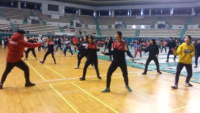
Purpose The purpose of this study was to investigate the effects of 3 weeks of fencing specific training on physical fitness in elite fencers. Methods Forty eight elite fencers participated in this program (Male= 24, Female= 24). Training program consists of dynamic stretching, step and agility training, and it was conducted with the general fencing practice during 3 weeks. Body composition and physical fitness (muscle strength/power, agility, anaerobic power and flexibility) were measured before and after training. Data were analyzed using IBM SPSS Statistics ver. 23.0 (IBM Co., Armonk, NY, USA). Paired t-test (pre vs. post) was used for comparison between groups. Results Muscle mass and body fat(%) were significantly changed after training in male group. Agility was significantly improved in change-step jump and reaction time after training both in male and female group. In Anaerobic power, peak power (relative power, absolute power) was significantly increased after training in female group. Flexibility was also significantly improved after training in left ankle ROM of female group. Conclusion Application of fencing specific training program focused on fencing movement seems to be effective on agility in both groups, muscle mass and body fat(%) in male group, and anaerobic power and flexibility in female group.

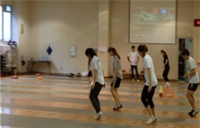


Purpose This study was conducted to analyze the differences of physical characteristics focused on the physique, strength, and power for cycling national athletes (Sprint cyclists and Road race cyclists). Methods We measured various factors (e.g., height, weight, body fat ratio, thigh circumference, waist circumference, anaerobic power, isokinetic muscular strength, muscle power, squat jump by 1RM intensity, and so on) for a total 11 male cycling national athletes (5 Sprint cyclists and 6 Road race cyclists). Results First, the body composition showed the significant differences only in weight (p=0.31) and BMI (p=.001) for Sprint cyclists. Second, the values of the anaerobic power for the Sprint cyclists were significantly higher than those for the Road race cyclists only at peak power (p=0.28), whereas there was no significant difference in average power, isokinetic muscular strength, and muscle power between the two groups. Third, the isokinetic trunk flexion muscle (p = .016) for the Sprint cyclists were significantly higher than those for the Road race cyclists. Fourth, the significant difference in Time to Peak Torque was not found between two groups. Fifth, the values for the Sprint cyclists showed the significant difference in all 5 intensity groups (0%, 30%, 50%, 60%, and 80%) (p=.001) of the squat jump. Also, there was a statistically significant difference only in 0% velocity between the two groups, except for exercise intensity. Conclusions From the various measures between two groups, the Sprint cyclists relatively showed the high weight, BMI (muscle mass), and maximum power. Additionally, the isokinetic trunk flexion muscle and the squat jump were higher in the Sprint cyclists than the Road race cyclists. These data may be used as basic data to improve the physical fitness factors related to the athletic performance of the athletes by reflecting them in the effective training plan and evaluation of the athletes.
Purpose The purpose of this study was to find out the physical characteristics of Wushu athletes by comparing the differences on the results of physical fitness between the male athletes of the Wushu national team Taolu and the Sanda group. Methods Measurement of basic and professional fitness based on muscle function, targeting 37 men Wushu national team players (24 taolu, 13 Sanda) in the selection and evaluation contests twice in 2018 and 2019. Body composition, isometric muscle strength, flexibility and equilibrium, anaerobic power, and isokinetic muscle strength. The fitness factors were divided into two groups, Taolu and Sanda. Results First, body fat rate of the Sanda athlete group was significantly lower than that of the taolu athlete group (p<.01). Second, in the isometric muscle strength category(back muscle strength, grip strength), the Sanda athlete group had higher muscle strength than Taolu athlete group, but there was a statistically significant difference only in the left grip strength (p<.01). Third, in terms of flexibility and equilibrium, the taolu players were significantly higher in all items(p<.001). Fourth, in the anaerobic power, the taolu athlete group had higher both the peak power and the mean power, and there were a significant differences(peak power: p<.01, mean power: p<.001). Fifth, isokinetic muscle strength was significantly higher in the right knee flexion of the taolu athlete group (p<.01), and lumbar extensor muscle was significantly higher in the Sanda athlete group (p<.05). Sixth, in the isokinetic strength ratio, the knee flexion ratio of the Sanda athlete group were significantly higher on the left and right knee flexion and extensor ratios (p<.05). In addition, in the lumbar flexor and extensor ratios, the group of Sanda athlete group were significantly higher on the lumbar extensor(p<.05). Seventh, there was no significant difference between two groups in isokinetic muscle power. Conclusions The results of this study can be used as basic data to improve the efficiency of technical and physical training through the analysis of the characteristics of Taolu and Sanda. The effectiveness of this training will help to improve the performance.
The purpose of this study was to examine the effect on Electro-chemical screen and anaerobic exercise capacity caused by short-term weight loss in amateur boxing players. Subjects of this study were 10 male university boxing player who conducted to weight loss methods. In 1st weight loss, boxing players took rapid weight loss during 5-7days, In 2nd weight loss, boxing players took weight loss 3kg during 2 weeks. The change of ECS and anaerobic exercise capacity were measured before and after weight loss period. Anaerobic exercise capacity was measured by 1RM of bench press and squat. In addition, using the wing-gate test muscle power and power endurance was evaluated. To find out the changes in ECS, urine and saliva was collected after waking up were analyzed. The results were as follow. First, 1RM of squat(p=.003), peak power(p=.023) and mean power(p=.015) showed significant decrease after 1st weight loss method. However in 2nd weight loss method, no factor of ECS and anaerobic exercise capacity were significantly decreased. Second, total urea(p=.015), urine rH2(p=.017), urine conductivity(p=.003), and utilization of vitamin(p=.005) showed significant decrease after 1st weight loss method. However in 2nd weight loss method, urine conductivity(p=.038) and saliva rH2(p=.028) showed significant increase after weight loss. In conclusion, amateur boxing players need a systematic weight loss to maintain optimal conditioning.
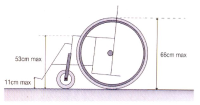
[Purpose] A potential issue for wheelchair sports are the characteristics of wheelchair design. The purpose of this review was to investigate the characteristics of design in wheelchair sports including the height of seat, camber and handrim size for improving the performance. [Results] The optimum height of seat related to trunk, arm length and handrim size. The lower seat showed the push efficient highly, while higher seat increased the energy expenditure. In energy expenditure, the optimum height of seat was 100-120° of elbow angle. Handrim size play the role in gear. The smaller handrim size acts like high gear, it gains disadvantages in acceleration, it gains advantages in maximum velocity. On the contrary, the higher handrim size acts like low gear, it gains disadvantages in maximum speed, it gains advantages in acceleration. The ratio of gear consideration in power and velocity. When increased camber enhanced the lateral stability, easier catch the handrim and easier arm motion. So it improved the energy expenditure and push technique. When increased camber enhanced the mechanical efficiency and stability, but it decreased the power. The racing wheelchair camber using the 8° and 10°. [Conclusion] Athletes, coaches and wheelchair experts are provided with insight in the performance effect of key wheelchair design settings, and they are offered a proven sensitive method to apply in sports practice, in their search for the best wheelchair-athlete combination.

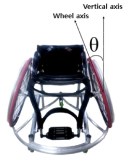
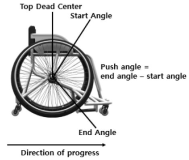
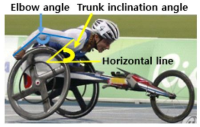
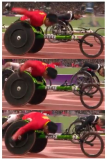
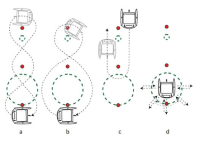
PURPOSE This study investigated the effects of 12 weeks of clubbell and stepbox training on physical fitness, badminton skills, and fatigue in male badminton, grade A (top grade) club members aged 20–30s, with over 5 years’ experience. METHODS Participants in a training group (TR: n=15) engaged in 12 weeks of clubbell and stepbox circuit training involving maximum 8–12 reps of clubbell exercises and stepbox exercises at over 77% of HRmax for 50–55 min/sessions three times a week. Participants in a control group (CON: n=15) maintained their normal lifestyle pattern during the same intervention period. Dependent variables were measured and compared using repeated measures two-way ANOVA. RESULTS The main results were as follows: 1) The groups showed no significant differences in body composition. 2) Regarding physical fitness, VO2max, relative peak power, relative average power, grip strength, push ups, repeated jump squats, SSPT (seated single-arm shot-put test), 10 m sprint, and hexagon agility increased significantly in the TR, while push ups decreased significantly in the CON. 3) As for badminton skills, forehand clear accuracy, badminton agility, badminton endurance, and smash speed increased significantly in the TR. Forehand clear accuracy decreased significantly in the CON, but badminton agility and smash speed increased significantly. 4) The groups showed no significant differences in fatigue. CONCLUSIONS In male badminton club members aged 20–30s, 12 weeks of clubbell and stepbox circuit training effectively improved physical fitness and badminton skills. However, lack of any improvement in body composition and fatigue warranted further research in these areas.